Multiscale Analysis for Identifying the Impact of Human and Natural Factors on Water-Related Ecosystem Services
Abstract
1. Introduction
2. Materials and Methods
2.1. Study Region
2.2. Data Sources and Preprocessing
2.3. Quantification of Water-Related Ecosystem Services
2.3.1. Water-Related Ecosystem Service Selection
2.3.2. Water Yield
2.3.3. Soil Conservation
2.3.4. Water Purification
2.3.5. Water-Related Ecosystem Services
2.4. Correlation Analysis of WES across Different Basins
- (i)
- WES calculation. With reference to the MA framework and the Common International Classification of Ecosystem Services (CICES), and considering the ecological properties of the study area, WY, SC, and WP were selected as the WES in this study. The correlation of the four factors was analyzed by using Spearman’s correlation, and the honorary data were excluded. The spatial map of WES supply from 2000 to 2020 was determined using the corresponding ecological model (Section 2.3.4). Global autocorrelation and local autocorrelation were used to analyze the spatial distribution of hot and cold spots of WES from 2000 to 2020.
- (ii)
- Impact strategies for long-term serial transformation analysis. Natural, anthropogenic, and WES data were evaluated from 2000 to 2020 using Sen’s slope estimator and the Mann–Kendall test.
- (iii)
- The interactions of composite factors affecting WES changes were explored using OPGD and MGWR models to understand the key drivers, synergistic impact effects, spatial variability, and magnitude of WES impacts in terms of spatial heterogeneity contributions, as well as driving and constraining relationships under long-time-series trends.

2.5. Relevance of Water-Related Ecosystem Services
2.6. Sen’s Slope Estimator and Mann–Kendall Test
2.7. Driving Mechanism Analysis
2.7.1. Optimal Parameter-Based Geographical Detector
- (1)
- Factor detector
- (2)
- Risk detector
- (3)
- Interaction detector
- (4)
- Selection and pre-treatment of impact factors
2.7.2. Multiscale Geographically Weighted Regression
3. Results
3.1. Ecological Environment Characteristics
3.2. Spatiotemporal Variation of Multiple WESs
3.3. Relationships between WESs
3.4. Driving Mechanism of the Coupling Coordination Relationship
3.4.1. Single-Factor Effect on the Spatial Heterogeneity of WESs
3.4.2. Influence of LULC on the WESs
3.4.3. Nonlinear Effects of Factors
3.4.4. Interaction between Factors Influencing the Spatial Heterogeneity of WESs
3.4.5. Spatial Characteristics of Factors Influencing WESs
4. Discussion
4.1. Impact of Human and Natural Factors on WESs
4.2. Policy Impacts
4.3. Comparisons with Previous Studies
4.4. Limitations and Prospects
5. Conclusions
Author Contributions
Funding
Institutional Review Board Statement
Informed Consent Statement
Data Availability Statement
Acknowledgments
Conflicts of Interest
References
- Costanza, R.; d’Arge, R.; De Groot, R.; Farber, S.; Grasso, M.; Hannon, B.; Limburg, K.; Naeem, S.; O‘neill, R.V.; Paruelo, J.; et al. The value of the world‘s ecosystem services and natural capital. Nature 1997, 387, 253–260. [Google Scholar] [CrossRef]
- Deng, X.; Li, Z.; Gibson, J. A review on trade-off analysis of ecosystem services for sustainable land-use management. J. Geogr. Sci. 2016, 26, 953–968. [Google Scholar] [CrossRef]
- Zhan, J.; Zhang, F.; Chu, X.; Liu, W.; Zhang, Y. Ecosystem services assessment based on emergy accounting in Chongming Island, Eastern China. Ecol. Indic. 2019, 105, 464–473. [Google Scholar] [CrossRef]
- Burkhard, B.; Kroll, F.; Nedkov, S.; Müller, F. Mapping ecosystem service supply, demand and budgets. Ecol. Indic. 2012, 21, 17–29. [Google Scholar] [CrossRef]
- Harris, J. Millennium Ecosystem Assessment; Cranfield University: Cranfield, UK, 2001. [Google Scholar]
- Li, Z.; Xia, J.; Deng, X.; Yan, H. Multilevel modelling of impacts of human and natural factors on ecosystem services change in an oasis, Northwest China. Resour. Conserv. Recycl. 2021, 169, 105474. [Google Scholar] [CrossRef]
- Shi, P.; Li, Z.; Li, P.; Zhang, Y.; Li, B. Trade-offs among ecosystem services after vegetation restoration in China’s Loess Plateau. Nat. Resour. Res. 2021, 30, 2703–2713. [Google Scholar] [CrossRef]
- Fu, Q.; Li, B.; Hou, Y.; Bi, X.; Zhang, X. Effects of land use and climate change on ecosystem services in Central Asia’s arid regions: A case study in Altay Prefecture, China. Sci. Total Environ. 2017, 607, 633–646. [Google Scholar] [CrossRef] [PubMed]
- Moss, E.D.; Evans, D.M.; Atkins, J.P. Investigating the impacts of climate change on ecosystem services in UK agro-ecosystems: An application of the DPSIR framework. Land Use Policy 2021, 105, 105394. [Google Scholar] [CrossRef]
- Ali, H.; Modi, P.; Mishra, V. Increased flood risk in Indian sub-continent under the warming climate. Weather. Clim. Extrem. 2019, 25, 100212. [Google Scholar] [CrossRef]
- Ma, S.; Li, Y.; Zhang, Y.; Wang, L.J.; Jiang, J.; Zhang, J. Distinguishing the relative contributions of climate and land use/cover changes to ecosystem services from a geospatial perspective. Ecol. Indic. 2022, 136, 108645. [Google Scholar] [CrossRef]
- Chícharo, L.; Chícharo, M.A.; Ben-Hamadou, R. Use of a hydrotechnical infrastructure (Alqueva Dam) to regulate planktonic assemblages in the Guadiana estuary: Basis for sustainable water and ecosystem services management. Estuar. Coast. Shelf Sci. 2006, 70, 3–18. [Google Scholar] [CrossRef]
- Hamidov, A.; Daedlow, K.; Webber, H.; Hussein, H.; Abdurahmanov, I.; Dolidudko, A.; Seerat, A.Y.; Solieva, U.; Woldeyohanes, T.; Helming, K. Operationalizing water-energy-food nexus research for sustainable development in social-ecological systems: An interdisciplinary learning case in Central Asia. Ecol. Soc. 2022, 27, 12. [Google Scholar] [CrossRef]
- Izah, S.C.; Iyiola, A.O.; Yarkwan, B.; Richard, G. Impact of air quality as a component of climate change on biodiversity-based ecosystem services. In Visualization Techniques for Climate Change with Machine Learning and Artificial Intelligence; Elsevier: Amsterdam, The Netherlands, 2023; pp. 123–148. [Google Scholar] [CrossRef]
- Xu, X.; Chen, M.; Yang, G.; Jiang, B.; Zhang, J. Wetland ecosystem services research: A critical review. Glob. Ecol. Conserv. 2020, 22, e01027. [Google Scholar] [CrossRef]
- Fernandes, B.S.; Gama, C.S.; Ceresér, K.M.; Yatham, L.N.; Fries, G.R.; Colpo, G.; de Lucena, D.; Kunz, M.; Gomes, F.A.; Kapczinski, F. Brain-derived neurotrophic factor as a state-marker of mood episodes in bipolar disorders: A systematic review and meta-regression analysis. J. Psychiatr. Res. 2011, 45, 995–1004. [Google Scholar] [CrossRef] [PubMed]
- Hong, K.; Liu, G.; Chen, W.; Hong, S. Classification of the emotional stress and physical stress using signal magnification and canonical correlation analysis. Pattern Recognit. 2018, 77, 140–149. [Google Scholar] [CrossRef]
- Greenspoon, P.J.; Saklofske, D.H. Confirmatory factor analysis of the multidimensional students’ life satisfaction scale. Personal. Individ. Differ. 1998, 25, 965–971. [Google Scholar] [CrossRef]
- Karakoç, Ö.; Es, H.A.; Fırat, S.Ü. Evaluation of the development level of provinces by grey cluster analysis. Procedia Comput. Sci. 2019, 158, 135–144. [Google Scholar] [CrossRef]
- Cagliero, C.; Bicchi, C.; Cordero, C.; Rubiolo, P.; Sgorbini, B.; Liberto, E. Fast headspace-enantioselective GC-mass spectrometric-multivariate statistical method for routine authentication of flavoured fruit foods. Food Chem. 2012, 132, 1071–1079. [Google Scholar] [CrossRef]
- Stoeckl, N.; Jarvis, D.; Larson, S.; Larson, A.; Grainger, D. Australian Indigenous insights into ecosystem services: Beyond services towards connectedness—People, place and time. Ecosyst. Serv. 2021, 50, 101341. [Google Scholar] [CrossRef]
- Tomczak, A.; Mortensen, J.M.; Winnenburg, R.; Liu, C.; Alessi, D.T.; Swamy, V.; Vallania, F.; Lofgren, S.; Haynes, W.; Shah, N.H.; et al. Interpretation of biological experiments changes with evolution of the Gene Ontology and its annotations. Sci. Rep. 2018, 8, 5115. [Google Scholar] [CrossRef]
- Chiabai, A.; Quiroga, S.; Martinez-Juarez, P.; Higgins, S.; Taylor, T. The nexus between climate change, ecosystem services and human health: Towards a conceptual framework. Sci. Total Environ. 2018, 635, 1191–1204. [Google Scholar] [CrossRef] [PubMed]
- Fang, L.; Wang, L.; Chen, W.; Sun, J.; Cao, Q.; Wang, S.; Wang, L. Identifying the impacts of natural and human factors on ecosystem service in the Yangtze and Yellow River Basins. J. Clean. Prod. 2021, 314, 127995. [Google Scholar] [CrossRef]
- Wang, X.; Wu, J.; Liu, Y.; Hai, X.; Shanguan, Z.; Deng, L. Driving factors of ecosystem services and their spatiotemporal change assessment based on land use types in the Loess Plateau. J. Environ. Manag. 2022, 311, 114835. [Google Scholar] [CrossRef] [PubMed]
- Zhang, S.; Zhang, W.; Liu, C. Research on Value Evaluation and Impact Mechanism of Water Ecological Services in Mountainous Cities: A Case Study of Xiangxi Prefecture. Sustainability 2023, 15, 1463. [Google Scholar] [CrossRef]
- Xu, W.; He, M.; Meng, W.; Zhang, Y.; Yun, H.; Lu, Y.; Huang, Z.; Mo, X.; Hu, B.; Liu, B.; et al. Temporal-spatial change of China’s coastal ecosystems health and driving factors analysis. Sci. Total Environ. 2022, 845, 157319. [Google Scholar] [CrossRef] [PubMed]
- Comber, A.; Brunsdon, C.; Charlton, M.; Dong, G.; Harris, R.; Lu, B.; Lü, Y.; Murakami, D.; Nakaya, T.; Wang, Y.; et al. The GWR route map: A guide to the informed application of Geographically Weighted Regression. arXiv 2020, arXiv:2004.06070. [Google Scholar] [CrossRef]
- Liu, L.; Yu, H.; Zhao, J.; Wu, H.; Peng, Z.; Wang, R. Multiscale effects of multimodal public facilities accessibility on housing prices based on MGWR: A case study of Wuhan, China. ISPRS Int. J. Geo-Inf. 2022, 11, 57. [Google Scholar] [CrossRef]
- Xue, C.; Xue, L.; Chen, J.; Tarolli, P.; Chen, X.; Zhang, H.; Qian, J.; Zhou, Y.; Liu, X. Understanding driving mechanisms behind the supply-demand pattern of ecosystem services for land-use administration: Insights from a spatially explicit analysis. J. Clean. Prod. 2023, 427, 139239. [Google Scholar] [CrossRef]
- Hackbart, V.C.; De Lima, G.T.; Dos Santos, R.F. Theory and practice of water ecosystem services valuation: Where are we going? Ecosyst. Serv. 2017, 23, 218–227. [Google Scholar] [CrossRef]
- Xue, J.; Lei, J.; Chang, J.; Zeng, F.; Zhang, Z.; Sun, H. A causal structure-based multiple-criteria decision framework for evaluating the water-related ecosystem service tradeoffs in a desert oasis region. J. Hydrol. Reg. Stud. 2022, 44, 101226. [Google Scholar] [CrossRef]
- Bi, Y.; Zheng, L.; Wang, Y.; Li, J.; Yang, H.; Zhang, B. Coupling relationship between urbanization and water-related ecosystem services in China’s Yangtze River economic Belt and its socio-ecological driving forces: A county-level perspective. Ecol. Indic. 2023, 146, 109871. [Google Scholar] [CrossRef]
- Brauman, K.A.; Daily, G.C.; Duarte, T.K.; Mooney, H.A. The nature and value of ecosystem services: An overview highlighting hydrologic services. Annu. Rev. Environ. Resour. 2007, 32, 67–98. [Google Scholar] [CrossRef]
- Fitoka, E.; Tompoulidou, M.; Hatziiordanou, L.; Apostolakis, A.; Höfer, R.; Weise, K.; Ververis, C. Water-related ecosystems’ mapping and assessment based on remote sensing techniques and geospatial analysis: The SWOS national service case of the Greek Ramsar sites and their catchments. Remote Sens. Environ. 2020, 245, 111795. [Google Scholar] [CrossRef]
- Alberti, M. Maintaining ecological integrity and sustaining ecosystem function in urban areas. Curr. Opin. Environ. Sustain. 2010, 2, 178–184. [Google Scholar] [CrossRef]
- Xie, X.; Fang, B.; Xu, H.; He, S.; Li, X. Study on the coordinated relationship between Urban Land use efficiency and ecosystem health in China. Land Use Policy 2021, 102, 105235. [Google Scholar] [CrossRef]
- Yang, S.; Bai, Y.; Alatalo, J.M.; Wang, H.; Jiang, B.; Liu, G.; Chen, J. Spatio-temporal changes in water-related ecosystem services provision and trade-offs with food production. J. Clean. Prod. 2021, 286, 125316. [Google Scholar] [CrossRef]
- Wang, Y.; Wang, H.; Zhang, J.; Liu, G.; Fang, Z.; Wang, D. Exploring interactions in water-related ecosystem services nexus in Loess Plateau. J. Environ. Manag. 2023, 336, 117550. [Google Scholar] [CrossRef]
- Li, J.; Zhou, K.; Xie, B.; Xiao, J. Impact of landscape pattern change on water-related ecosystem services: Comprehensive analysis based on heterogeneity perspective. Ecol. Indic. 2021, 133, 108372. [Google Scholar] [CrossRef]
- Hutchinson, M.F.; Xu, T. ANUSPLIN Version 4.4 User Guide; Centre for Resource and Environmental Studies, The Australian National University: Canberra, Australia, 2004; p. 54. Available online: https://fennerschool.anu.edu.au/files/anusplin44.pdf (accessed on 11 October 2023).
- Zhang, L.; Ren, Z.; Chen, B.; Gong, P.; Fu, H.; Xu, B. A Prolonged Artificial Nighttime-Light Dataset of China (1984–2020); National Tibetan Plateau Data Center: Beijing, China, 2021. [Google Scholar]
- Green, P.A.; Vörösmarty, C.J.; Harrison, I.; Farrell, T.; Sáenz, L.; Fekete, B.M. Freshwater ecosystem services supporting humans: Pivoting from water crisis to water solutions. Glob. Environ. Chang. 2015, 34, 108–118. [Google Scholar] [CrossRef]
- Vigerstol, K.L.; Aukema, J.E. A comparison of tools for modeling freshwater ecosystem services. J. Environ. Manag. 2011, 92, 2403–2409. [Google Scholar] [CrossRef] [PubMed]
- Piaggio, M.; Siikamäki, J. The value of forest water purification ecosystem services in Costa Rica. Sci. Total Environ. 2021, 789, 147952. [Google Scholar] [CrossRef] [PubMed]
- Zhang, M.; Ma, S.; Gong, J.W.; Chu, L.; Wang, L.J. A coupling effect of landscape patterns on the spatial and temporal distribution of water ecosystem services: A case study in the Jianghuai ecological economic zone, China. Ecol. Indic. 2023, 151, 110299. [Google Scholar] [CrossRef]
- Li, Z.; Qiu, Y.; Zhao, D.; Li, J.; Li, G.; Jia, H.; Du, D.; Dang, Z.; Lu, G.; Li, X.; et al. Application of apatite particles for remediation of contaminated soil and groundwater: A review and perspectives. Sci. Total Environ. 2023, 7, 166918. [Google Scholar] [CrossRef] [PubMed]
- Liang, H.; Yang, S.; Xu, J.; Hu, K. Modeling water consumption, N fates, and rice yield for water-saving and conventional rice production systems. Soil Tillage Res. 2021, 209, 104944. [Google Scholar] [CrossRef]
- Sharp, R.; Douglass, J.; Wolny, S.; Arkema, K.; Bernhardt, J.; Bierbower, W.; Chaumont, N.; Denu, D.; Fisher, D.; Glowinski, K.; et al. InVEST 3.8. 7. User’s Guide; The Natural Capital Project: Stanford, CA, USA; Standford University: Stanford, CA, USA; University of Minnesota: Minneapolis, MN, USA; The Nature Conservancy, and World Wildlife Fund: Standford, CA, USA, 2020. [Google Scholar]
- Liang, J.; Li, S.; Li, X.; Li, X.; Liu, Q.; Meng, Q.; Lin, A.; Li, J. Trade-off analyses and optimization of water-related ecosystem services (WRESs) based on land use change in a typical agricultural watershed, southern China. J. Clean. Prod. 2021, 279, 123851. [Google Scholar] [CrossRef]
- Lyu, R.; Clarke, K.C.; Zhang, J.; Feng, J.; Jia, X.; Li, J. Spatial correlations among ecosystem services and their socio-ecological driving factors: A case study in the city belt along the Yellow River in Ningxia, China. Appl. Geogr. 2019, 108, 64–73. [Google Scholar] [CrossRef]
- Yan, J.; Zhang, G.; Ling, H.; Han, F. Comparison of time-integrated NDVI and annual maximum NDVI for assessing grassland dynamics. Ecol. Indic. 2022, 136, 108611. [Google Scholar] [CrossRef]
- Ma, Z.; Yan, N.; Wu, B.; Stein, A.; Zhu, W.; Zeng, H. Variation in actual evapotranspiration following changes in climate and vegetation cover during an ecological restoration period (2000–2015) in the Loess Plateau, China. Sci. Total Environ. 2019, 689, 534–545. [Google Scholar] [CrossRef]
- Zhao, Y.; Wang, S.; Ge, Y.; Liu, Q.; Liu, X. The spatial differentiation of the coupling relationship between urbanization and the eco-environment in countries globally: A comprehensive assessment. Ecol. Model. 2017, 360, 313–327. [Google Scholar] [CrossRef]
- Wang, J.F.; Li, X.H.; Christakos, G.; Liao, Y.L.; Zhang, T.; Gu, X.; Zheng, X.Y. Geographical detectors-based health risk assessment and its application in the neural tube defects study of the Heshun Region, China. Int. J. Geogr. Inf. Sci. 2010, 24, 107–127. [Google Scholar] [CrossRef]
- Wang, J.F.; Zhang, T.L.; Fu, B.J. A measure of spatial stratified heterogeneity. Ecol. Indic. 2016, 67, 250–256. [Google Scholar] [CrossRef]
- Chen, T.; Feng, Z.; Zhao, H.; Wu, K. Identification of ecosystem service bundles and driving factors in Beijing and its surrounding areas. Sci. Total Environ. 2020, 711, 134687. [Google Scholar] [CrossRef] [PubMed]
- Lorilla, R.S.; Poirazidis, K.; Detsis, V.; Kalogirou, S.; Chalkias, C. Socio-ecological determinants of multiple ecosystem services on the Mediterranean landscapes of the Ionian Islands (Greece). Ecol. Model. 2020, 422, 108994. [Google Scholar] [CrossRef]
- Sannigrahi, S.; Zhang, Q.; Pilla, F.; Joshi, P.K.; Basu, B.; Keesstra, S.; Roy, P.S.; Wang, Y.; Sutton, P.C.; Chakraborti, S.; et al. Responses of ecosystem services to natural and anthropogenic forcings: A spatial regression based assessment in the world’s largest mangrove ecosystem. Sci. Total Environ. 2020, 715, 137004. [Google Scholar] [CrossRef] [PubMed]
- Braun, D.; de Jong, R.; Schaepman, M.E.; Furrer, R.; Hein, L.; Kienast, F.; Damm, A. Ecosystem service change caused by climatological and non-climatological drivers: A Swiss case study. Ecol. Appl. 2019, 29, e01901. [Google Scholar] [CrossRef] [PubMed]
- Schirpke, U.; Candiago, S.; Vigl, L.E.; Jäger, H.; Labadini, A.; Marsoner, T.; Meisch, C.; Tasser, E.; Tappeiner, U. Integrating supply, flow and demand to enhance the understanding of interactions among multiple ecosystem services. Sci. Total Environ. 2019, 651, 928–941. [Google Scholar] [CrossRef] [PubMed]
- Naidoo, R.; Balmford, A.; Costanza, R.; Fisher, B.; Green, R.E.; Lehner, B.; Malcolm, T.R.; Ricketts, T.H. Global mapping of ecosystem services and conservation priorities. Proc. Natl. Acad. Sci. USA 2008, 105, 9495–9500. [Google Scholar] [CrossRef]
- Zhang, Z.; Liu, Y.; Wang, Y.; Liu, Y.; Zhang, Y.; Zhang, Y. What factors affect the synergy and tradeoff between ecosystem services, and how, from a geospatial perspective? J. Clean. Prod. 2020, 257, 120454. [Google Scholar] [CrossRef]
- Charlton, M.; Fotheringham, S.; Brunsdon, C. Geographically Weighted Regression; White Paper. 2009. Available online: https://www.geos.ed.ac.uk/~gisteac/fspat/gwr/gwr_arcgis/GWR_WhitePaper.pdf (accessed on 21 October 2023).
- Fotheringham, A.S.; Charlton, M.E.; Brunsdon, C. Geographically weighted regression: A natural evolution of the expansion method for spatial data analysis. Environ. Plan. A 1988, 30, 1905–1927. [Google Scholar] [CrossRef]
- Oshan, T.M.; Li, Z.; Kang, W.; Wolf, L.J.; Fotheringham, A.S. MGWR: A Python implementation of multiscale geographically weighted regression for investigating process spatial heterogeneity and scale. ISPRS Int. J. Geo-Inf. 2019, 8, 269. [Google Scholar] [CrossRef]
- Mansour, S.; Al Kindi, A.; Al-Said, A.; Al-Said, A.; Atkinson, P. Sociodemographic determinants of COVID-19 incidence rates in Oman: Geospatial modelling using multiscale geographically weighted regression (MGWR). Sustain. Cities Soc. 2021, 65, 102627. [Google Scholar] [CrossRef] [PubMed]
- Ghosh, S.; Dinda, S.; Chatterjee, N.D.; Dutta, S.; Bera, D. Spatial-explicit carbon emission-sequestration balance estimation and evaluation of emission susceptible zones in an Eastern Himalayan city using Pressure-Sensitivity-Resilience framework: An approach towards achieving low carbon cities. J. Clean. Prod. 2022, 336, 130417. [Google Scholar] [CrossRef]
- Cumming, G.S.; Buerkert, A.; Hoffmann, E.M.; Schlecht, E.; von Cramon-Taubadel, S.; Tscharntke, T. Implications of agricultural transitions and urbanization for ecosystem services. Nature 2014, 515, 50–57. [Google Scholar] [CrossRef] [PubMed]
- Felipe-Lucia, M.R.; Soliveres, S.; Penone, C.; Fischer, M.; Ammer, C.; Boch, S.; Boeddinghaus, R.S.; Bonkowski, M.; Buscot, F.; Fiore-Donno, A.M.; et al. Land-use intensity alters networks between biodiversity, ecosystem functions, and services. Proc. Natl. Acad. Sci. USA 2020, 117, 28140–28149. [Google Scholar] [CrossRef] [PubMed]
- Im, R.Y.; Kim, J.Y.; Nishihiro, J.; Joo, G.J. Large weir construction causes the loss of seasonal habitat in riverine wetlands: A case study of the Four Large River Projects in South Korea. Ecol. Eng. 2020, 152, 105839. [Google Scholar] [CrossRef]
- Van Coppenolle, R.; Temmerman, S. Identifying global hotspots where coastal wetland conservation can contribute to nature-based mitigation of coastal flood risks. Glob. Planet. Chang. 2020, 187, 103125. [Google Scholar] [CrossRef]
- Bai, Y.; Ochuodho, T.O.; Yang, J. Impact of land use and climate change on water-related ecosystem services in Kentucky, USA. Ecol. Indic. 2019, 102, 51–64. [Google Scholar] [CrossRef]
- Zhao, L.; Ping, C.L.; Yang, D.; Cheng, G.; Ding, Y.; Liu, S. Changes of climate and seasonally frozen ground over the past 30 years in Qinghai–Xizang (Tibetan) Plateau, China. Glob. Planet. Chang. 2004, 43, 19–31. [Google Scholar] [CrossRef]
- Zhu, Z.; Wang, K.; Lei, M.; Li, X.; Li, X.; Jiang, L.; Gao, X.; Li, S.; Liang, J. Identification of priority areas for water ecosystem services by a techno-economic, social and climate change modeling framework. Water Res. 2022, 221, 118766. [Google Scholar] [CrossRef]
- Li, J.; Xie, B.; Gao, C.; Zhou, K.; Liu, C.; Zhao, W.; Xiao, J.; Xie, J. Impacts of natural and human factors on water-related ecosystem services in the Dongting Lake Basin. J. Clean. Prod. 2022, 370, 133400. [Google Scholar] [CrossRef]
- Tran, D.X.; Pearson, D.; Palmer, A.; Gray, D. Developing a landscape design approach for the sustainable land management of hill country farms in New Zealand. Land 2020, 9, 185. [Google Scholar] [CrossRef]
- Gomes, L.C.; Bianchi, F.J.J.A.; Cardoso, I.M.; Filho, E.I.F.; Rogier, P.O. Land use change drives the spatio-temporal variation of ecosystem services and their interactions along an altitudinal gradient in Brazil. Landsc. Ecol. 2020, 35, 1571–1586. [Google Scholar] [CrossRef]
- Salvati, L.; Zambon, I.; Chelli, F.M.; Serra, P. Do spatial patterns of urbanization and land consumption reflect different socioeconomic contexts in Europe? Sci. Total Environ. 2018, 625, 722–730. [Google Scholar] [CrossRef]
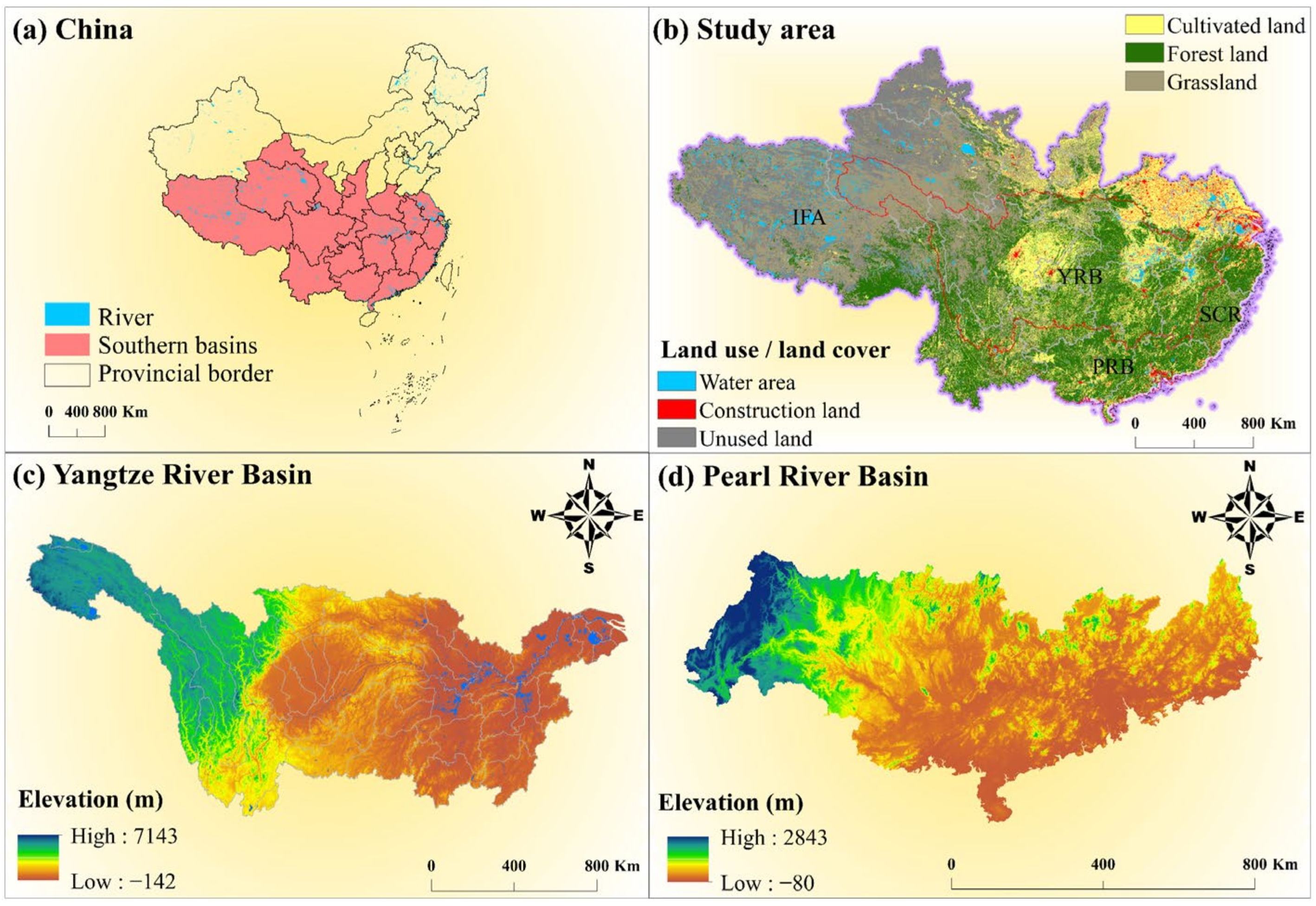





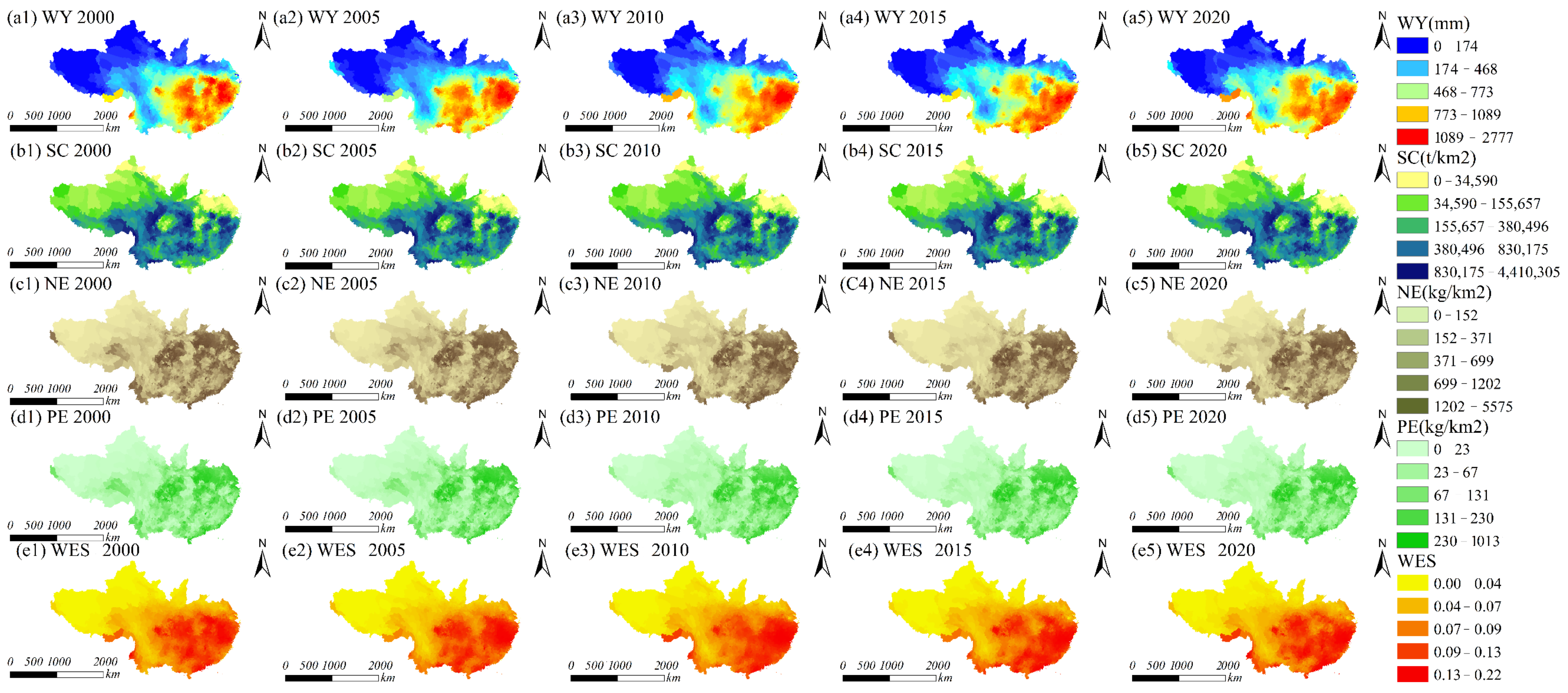
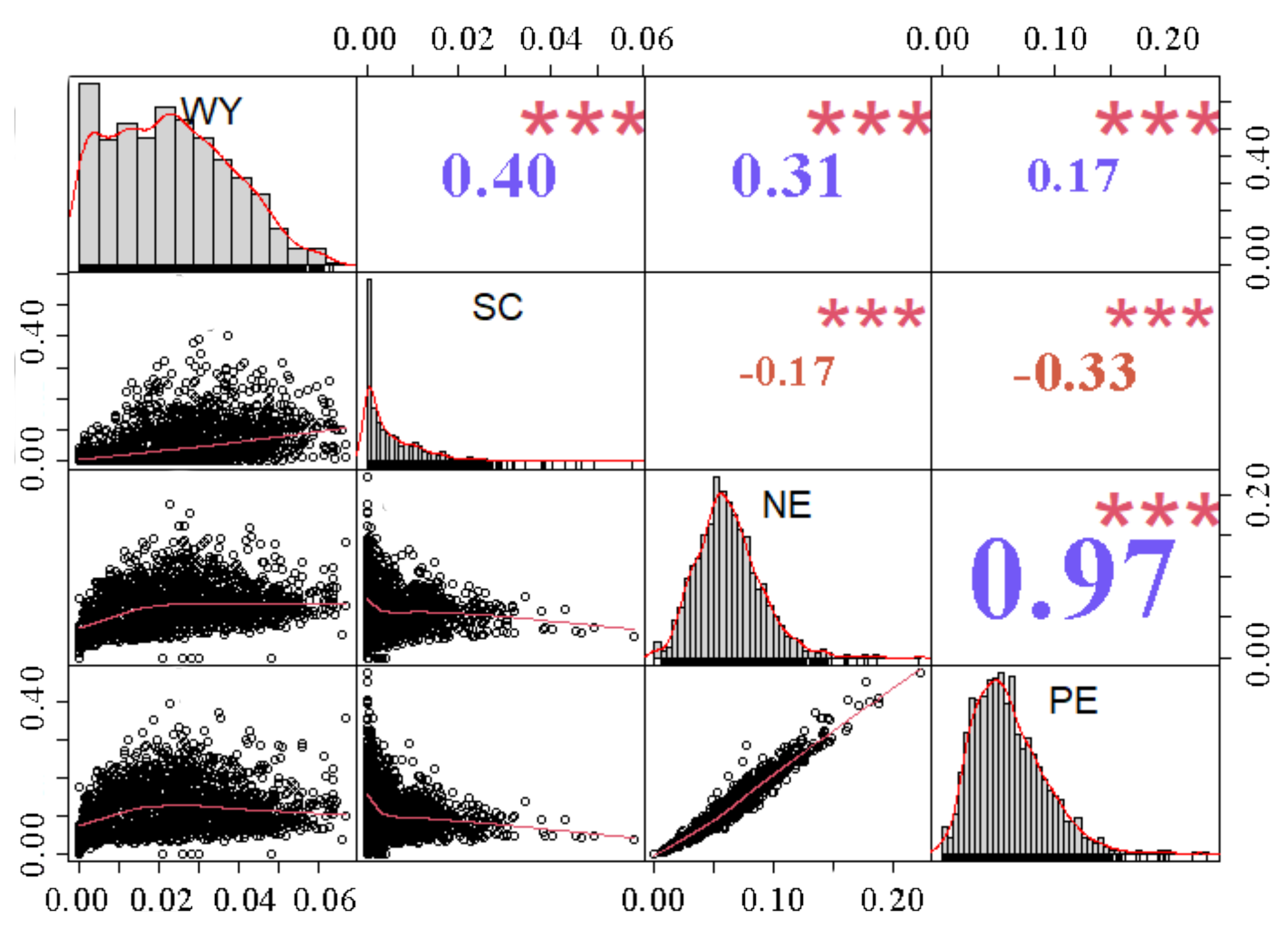

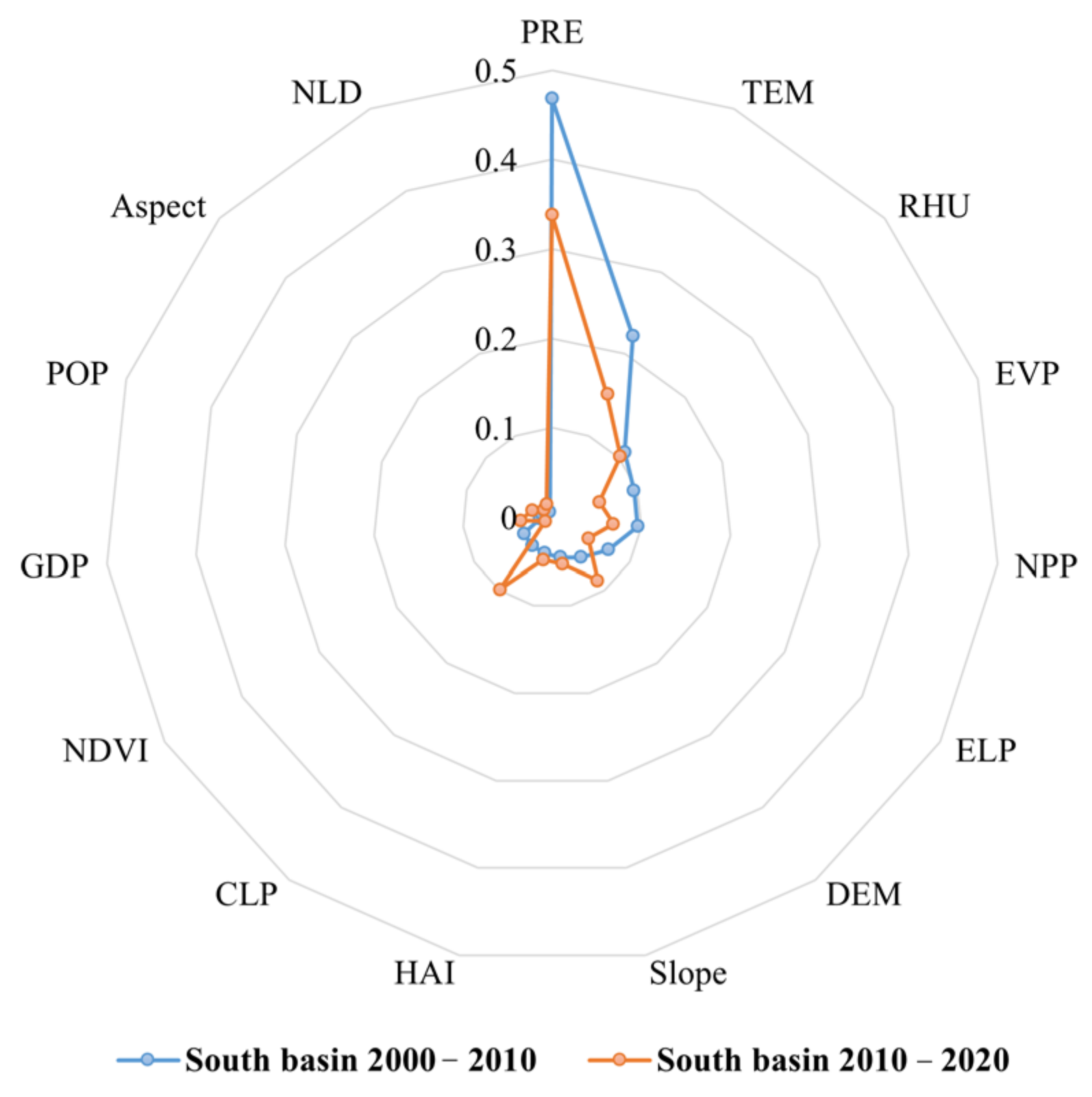
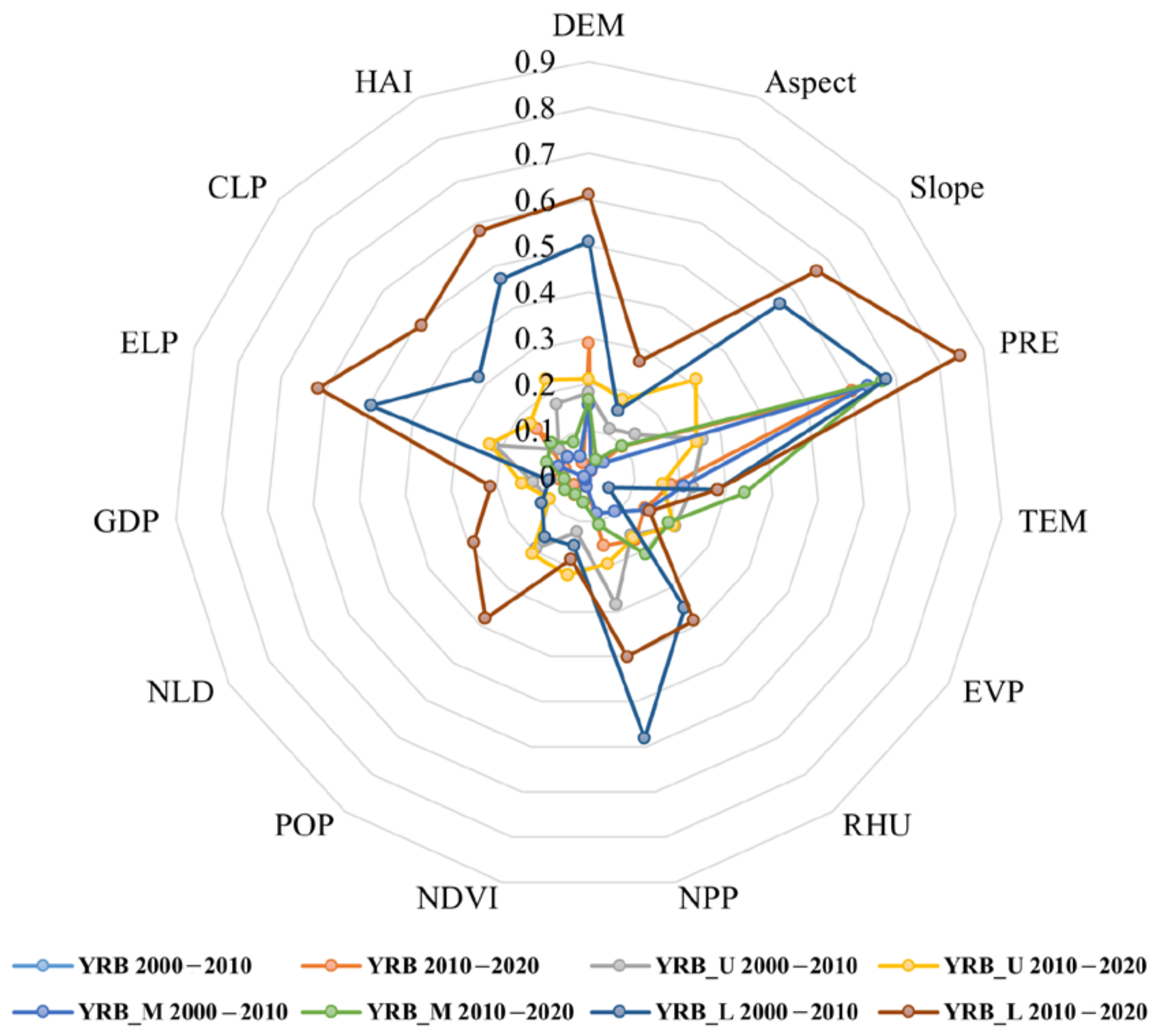
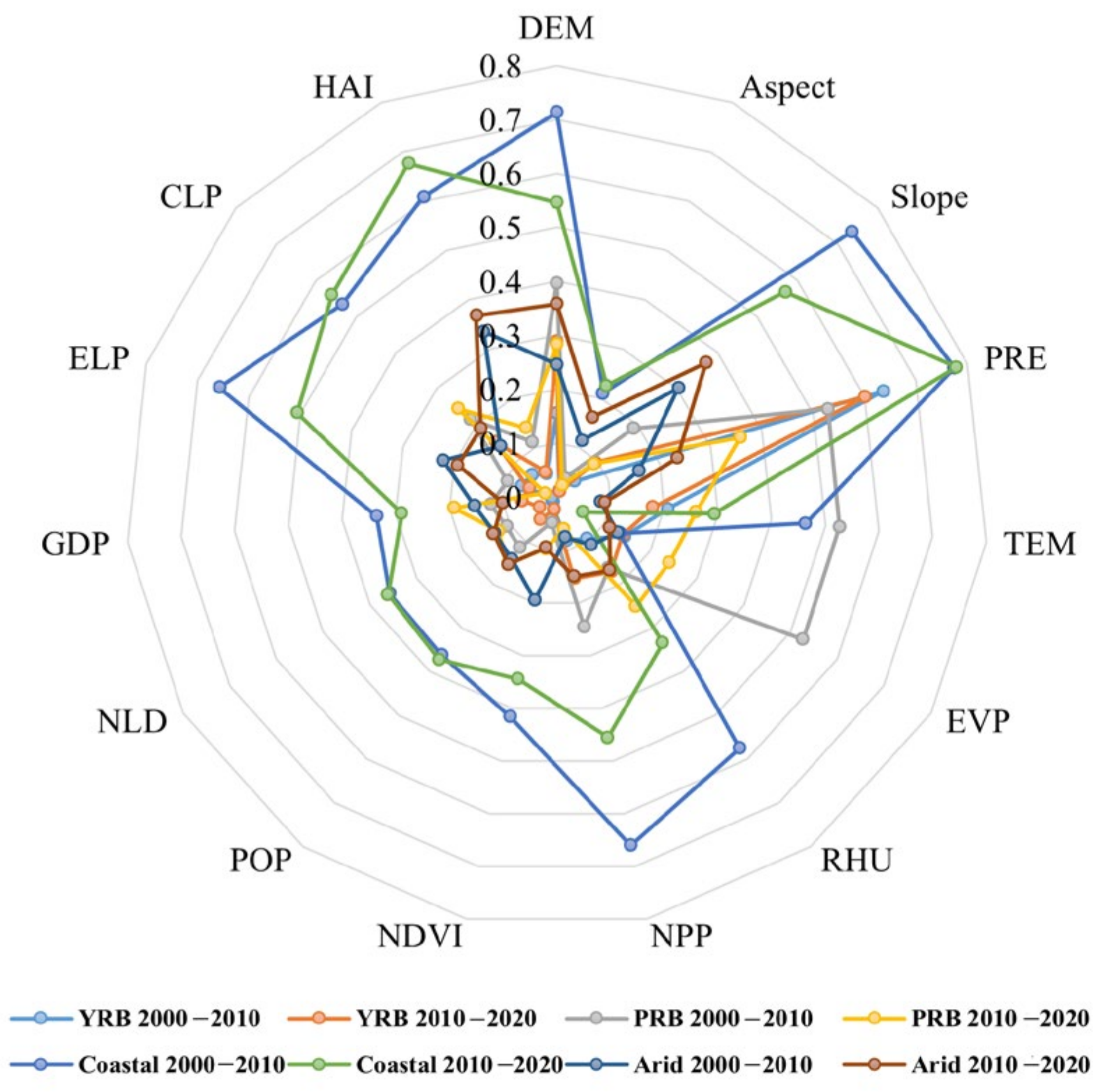

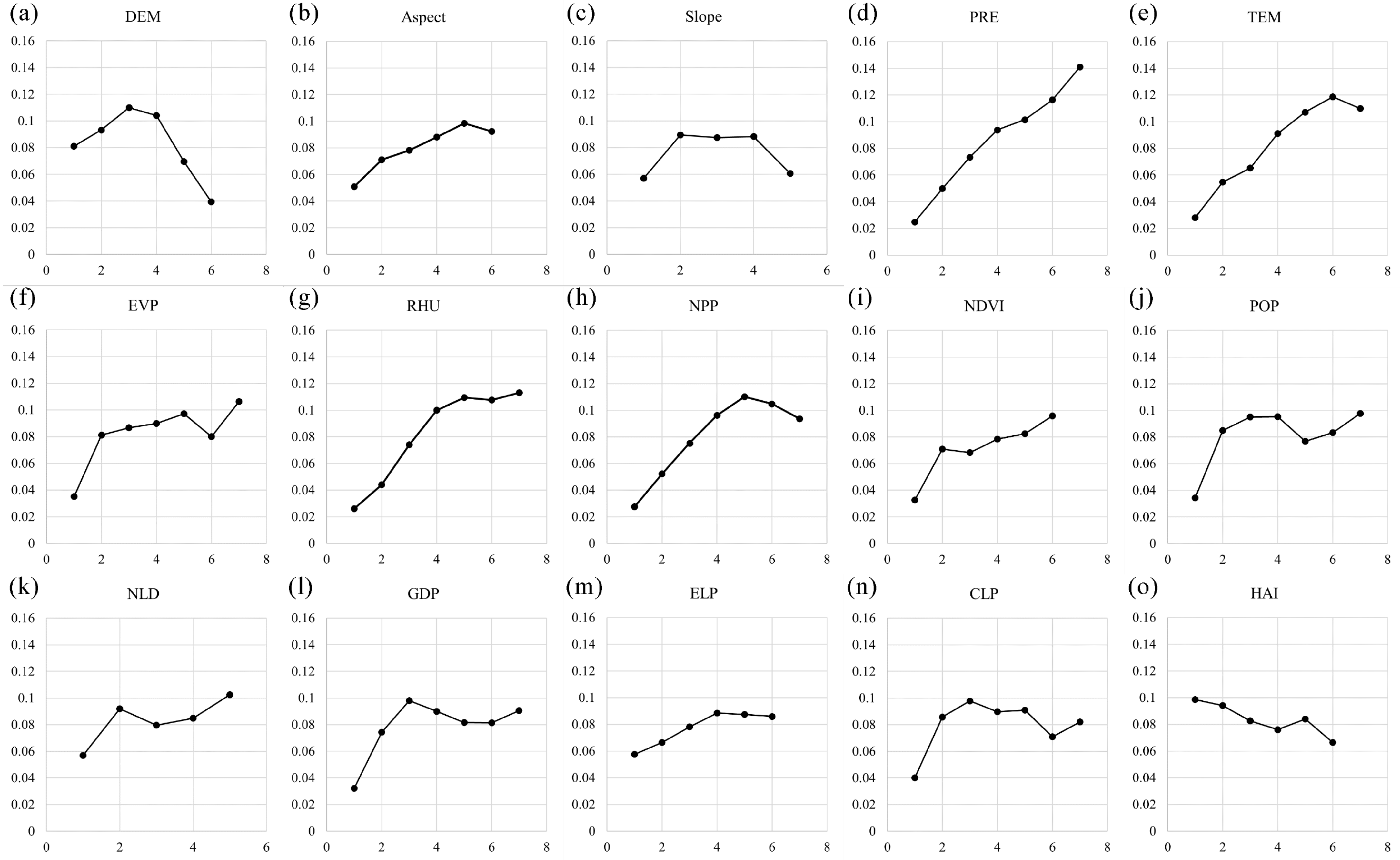

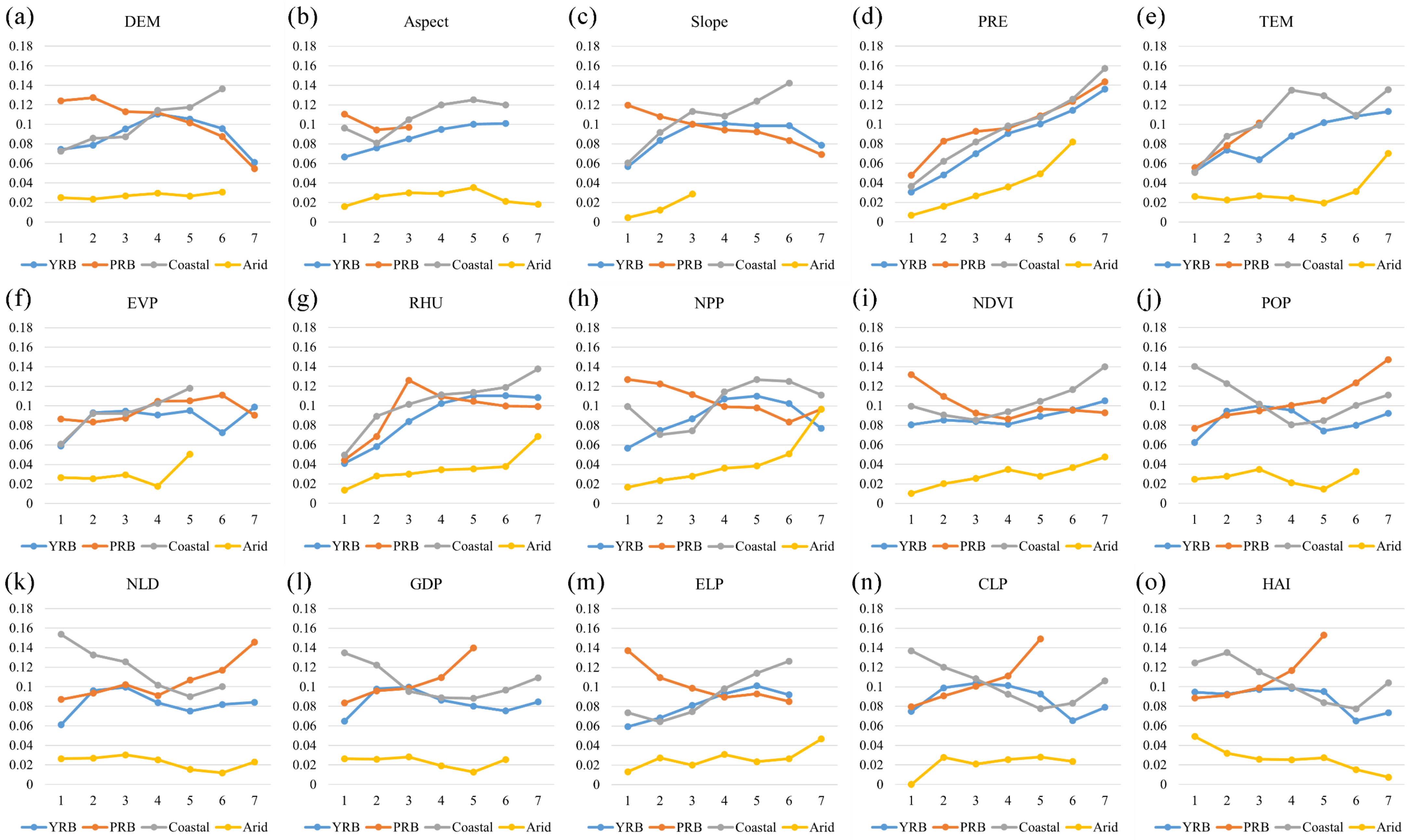
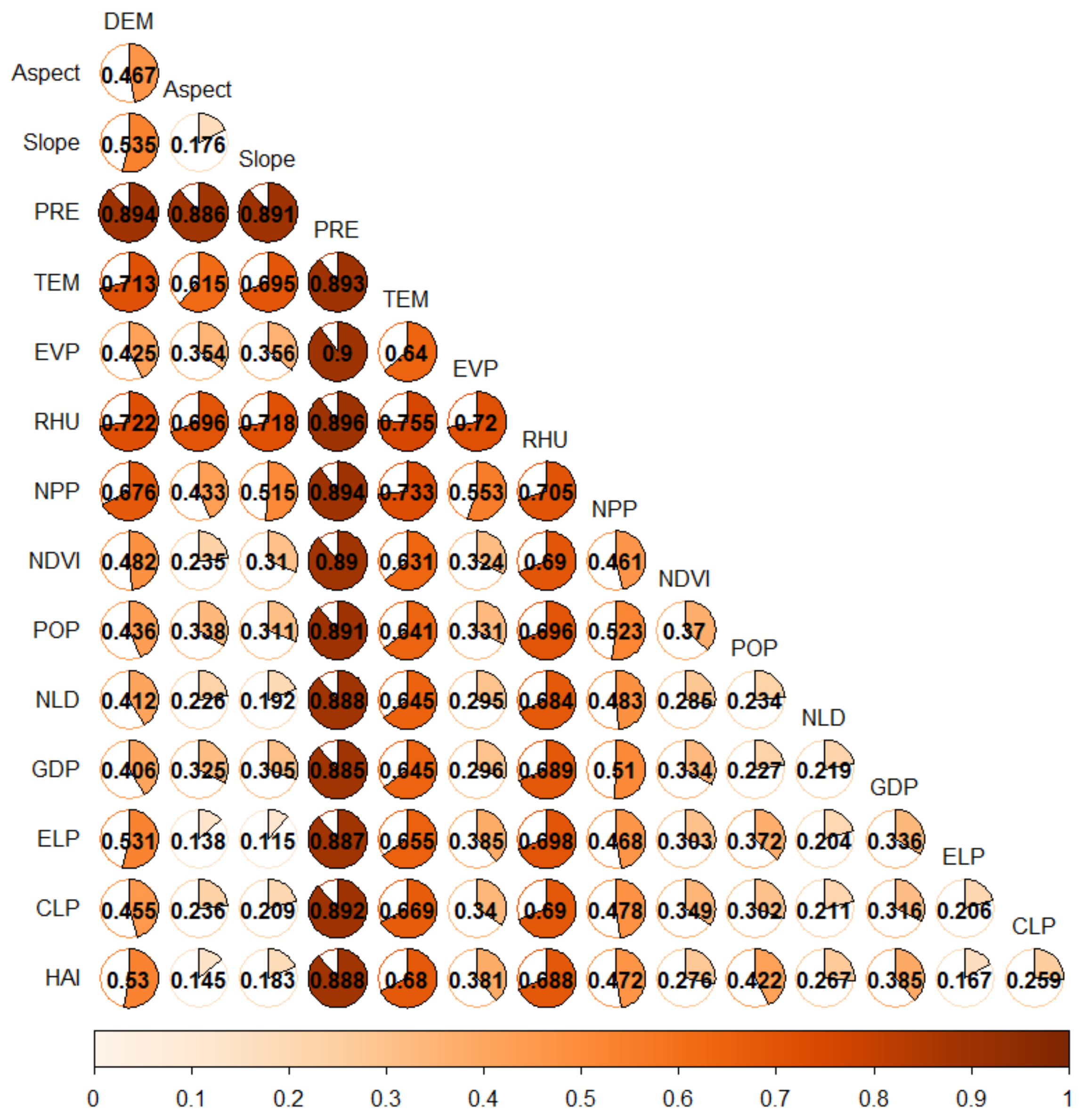

| Dataset | Source | Spatiotemporal Resolution | Source/Download Site |
|---|---|---|---|
| Land use and land cover (LULC) | Institute of Geographic Sciences and Natural Resources Research, China | 30 m | http://www.resdc.cn/, accessed on 19 September 2023 |
| DEM | Geospatial Data Cloud Platform | 30 m | http://www.gscloud.cn/, accessed on 21 September 2023 |
| Soil | Resource and Environment Science and Data Centre | 1000 m | http://www.resdc.cn/, accessed on 22 September 2023 |
| Temperature (TEM), relative humidity (REH), precipitation (PRE), evaporation (EVA), sunshine duration (SUN) | China Daily Surface Climate dataset (V3.0) | / | China Meteorological Data Website (http://data.cma.cn, accessed on 11 September 2023) |
| Normalized Difference Vegetation Index (NDVI) | Resource and Environment Science and Data Center | 1000 m | http://www.resdc.cn/, accessed on 19 September 2023 |
| Vegetation-available water content | |||
| where, PAWC represents the water content available to plants, while sand, silt, and clay denote the proportions of gravel, silt, and clay in the soil, respectively. OM represents the soil’s organic matter content. | |||
| Annual rainfall erosivity | |||
| where, Rn is the rainfall erosivity of the n-th year; Pn is the rainfall in the n-th year. | |||
| Soil erodibility | |||
| where, K represents soil erodibility, wherein a higher K value denotes lower corrosion resistance, and conversely, a lower value indicates higher resistance. The outcome is then multiplied by 0.1317 to standardize it in the international system of units. SAN, SIL, and CLA represent the sand, silt, and clay content, respectively, in the soil particle classification standard. SN1 is calculated as 1 minus SAN divided by 100. Additionally, C signifies the organic carbon content. | |||
| Description | Subclasses | root_depth | Kc | LULC_veg | Usle_c | usle_p | load_n | eff_n | crit_len_n | Load_p | eff_p | Crit_len_p |
|---|---|---|---|---|---|---|---|---|---|---|---|---|
| cultivated land | paddy field | 300 | 1.1 | 1 | 0.3 | 0.2 | 15.5 | 0.25 | 30 | 1.73 | 0.25 | 30 |
| dry land | 1000 | 0.7 | 1 | 0.35 | 0.3 | 15.5 | 0.25 | 30 | 1.73 | 0.25 | 30 | |
| forest land | forest land | 3500 | 1 | 1 | 0.006 | 1 | 2.5 | 0.7 | 300 | 0.15 | 0.7 | 300 |
| shrubbery | 1500 | 0.8 | 1 | 0.01 | 1 | 2.5 | 0.7 | 300 | 0.15 | 0.7 | 300 | |
| sparse forest land | 3500 | 0.9 | 1 | 0.017 | 1 | 2.5 | 0.7 | 300 | 0.15 | 0.7 | 300 | |
| other forest land | 3500 | 1 | 1 | 0.06 | 1 | 15.5 | 0.7 | 300 | 1.73 | 0.7 | 300 | |
| grassland | high coverage grassland | 800 | 0.7 | 1 | 0.02 | 1 | 6 | 0.48 | 150 | 0.8 | 0.48 | 150 |
| medium coverage grassland | 800 | 0.65 | 1 | 0.04 | 1 | 6 | 0.48 | 150 | 0.8 | 0.48 | 150 | |
| low coverage grassland | 800 | 0.6 | 1 | 0.1 | 1 | 6 | 0.48 | 150 | 0.8 | 0.48 | 150 | |
| water area | river and canal | 1 | 1.05 | 0 | 0 | 0 | 0.001 | 0.05 | 30 | 0.001 | 0.05 | 30 |
| lake | 1 | 1.05 | 0 | 0 | 0 | 0.001 | 0.05 | 30 | 0.001 | 0.05 | 30 | |
| reservoir pond | 1 | 1.05 | 0 | 0 | 0 | 0.001 | 0.05 | 30 | 0.001 | 0.05 | 30 | |
| permanent glacier snow | 1 | 0.5 | 0 | 0 | 0 | 0.001 | 0.05 | 30 | 0.001 | 0.05 | 30 | |
| beach | 1 | 1.05 | 0 | 0 | 0 | 0.001 | 0.05 | 30 | 0.001 | 0.05 | 30 | |
| swampland | 500 | 1.1 | 0 | 0 | 1 | 0.001 | 0.05 | 30 | 0.001 | 0.05 | 30 | |
| construction land | urban land | 1 | 0.43 | 0 | 0 | 0 | 11 | 0.05 | 30 | 1.8 | 0.05 | 30 |
| rural residential area | 1 | 0.5 | 0 | 0 | 0 | 11 | 0.05 | 30 | 1.8 | 0.05 | 30 | |
| other construction | 1 | 0.35 | 0 | 0 | 0 | 11 | 0.05 | 30 | 1.8 | 0.05 | 30 | |
| bare land | 1 | 0.5 | 0 | 1 | 1 | 11 | 0.05 | 30 | 0.36 | 0.05 | 30 | |
| unused land | stone land | 1 | 0.5 | 0 | 0 | 1 | 11 | 0.05 | 30 | 1.8 | 0.05 | 30 |
| River | 2000 | 2005 | 2010 | 2015 | 2020 | |
|---|---|---|---|---|---|---|
| Xiangjiang River | Observed data | 764.53 | 713.03 | 822.85 | 824.05 | 641.02 |
| Modeled data | 813.08 | 759.14 | 945.41 | 816.62 | 625.07 | |
| Error rate/% | −6.35 | −6.47 | −14.89 | 0.9 | 2.49 | |
| Yuanjiang River | Observed data | 630.63 | 535.76 | 683.23 | 734.79 | 937.72 |
| Modeled data | 739.02 | 540.65 | 748.99 | 781.9 | 929.36 | |
| Error rate/% | 17.19 | −0.91 | −9.63 | −6.41 | 0.89 | |
| Zishui River | Observed data | 243.33 | 247.59 | 241.78 | 227.45 | 283.55 |
| Modeled data | 222.86 | 269.56 | 244.15 | 238.59 | 278.03 | |
| Error rate/% | 8.41 | −8.87 | −0.98 | −4.90 | 1.95 | |
| Lishui River | Observed data | 131.03 | 109.60 | 163.32 | 154.63 | 227.36 |
| Modeled data | 143.34 | 119.39 | 175.41 | 167.50 | 205.85 | |
| Error rate/% | −9.40 | −8.93 | −7.40 | −8.32 | 9.46 | |
| Dongting Lake Basin | Observed data | 2184.81 | 2105.03 | 2450.17 | 2501.27 | 2803.21 |
| Modeled data | 2016.27 | 2009.27 | 2505.49 | 2092.97 | 2667.79 | |
| Error rate/% | 7.71 | 4.55 | −2.26 | 16.32 | 4.83 |
| Measured Value | Calculated Value | Error Rate/% | ||
|---|---|---|---|---|
| LULC | Soil Loss/Tons·km−2·yr−1 | LULC | Soil Loss/Tons·km−2·yr−1 | |
| Economic fruit tree | 1223.32 | Forestland | 1441.49 | 17.83 |
| Greening grassland | 1162.59 | 23.99 | ||
| Bare land | 1972.89 | −26.94 | ||
| Average | 1452.93 | −00.79 | ||
| β | Z | Trend Type | Trend Features |
|---|---|---|---|
| β > 0 | 1.96 < Z | 3 | Significantly increased |
| 1.65 < Z ≤ 1.96 | 2 | Marginally significantly increased | |
| Z ≤ 1.65 | 1 | Nonsignificantly increased | |
| β = 0 | Z | 0 | No change |
| β < 0 | 1.96 < Z | −1 | Nonsignificantly reduced |
| 1.65 < Z ≤ 1.96 | −2 | Marginally significantly reduced | |
| Z ≤ 1.65 | −3 | Significantly reduced |
| Description | Interaction Type |
|---|---|
| Nonlinear weakening | |
| Nonlinear weakening for single factor | |
| Bivariate enhancement | |
| Independence | |
| Nonlinear enhancement |
| Category | Factor | Abbreviation | Description |
|---|---|---|---|
| Topography | Digital Elevation Model | DEM | Based on digital elevation data extraction |
| Slope | Slope | Extracted from digital elevation models | |
| Aspect | ASP | ||
| Climate | Total annual precipitation | PRE | According to meteorological station monitoring data, spatial interpolation was performed using ANUSPLIN software (version 4.36) to generate raster data with a resolution of 30 m. Longitude and latitude were used as independent variables, while elevation was used as a covariate. |
| Average annual temperature | TEM | ||
| Total annual evapotranspiration | EVP | ||
| Annual mean relative humidity | RHU | ||
| Vegetation | Normalized Difference Vegetation Index | NDVI | Based on a spatial distribution dataset of monthly 1 km Normalized Difference Vegetation Index (NDVI) in China, the maximum values for the months of March to August are used to represent the annual vegetation condition. |
| Net primary productivity | NPP | Net uptake of photosynthetic organic matter per unit area of vegetation per unit of time. | |
| Socio-economics | Population density | POP | Nighttime light line data have been found to be closely related to economic activities. NLD, POP, and GDP are used to reflect the socio-economic characteristics of the basin. |
| Nighttime lighting data | NLD | ||
| Gross domestic product | GDP | ||
| Land use and land cover | Percentage of ecological land | ELP | The percentage of land area covered by forests, grasslands, and water bodies represents the characteristics of LULC composition in the region. |
| Percentage of construction land | CLP | The percentage of land area designated for construction use in the region represents the characteristics of LULC composition. | |
| Human activity intensity | HAI | where, HAI represents the intensity of human activities (%); SCLE is the area of various LULC types converted to construction land area; S is the grid cell area; SL is the area of each land type; CL is the construction land conversion coefficient for each land type, where the conversion coefficients for cultivated land, grassland, and urban and rural industrial and mining land are 0.4, 0.067, and 1, respectively. The conversion coefficients for other land types are 0. |
| Area Unit: % | Significantly Increased | Marginally Significantly Increased | Nonsignificantly Increased | No Change | Nonsignificantly Reduced | Marginally Significantly Reduced | Significantly Reduced |
|---|---|---|---|---|---|---|---|
| WESs | / | +1.70 | +59.92 | / | −37.01 | −1.18 | −0.19 |
| WY | +0.04 | +3.64 | +58.71 | 0.08 | −32.12 | −4.23 | −0.98 |
| SC | +3.45 | +5.81 | +44.97 | / | −26.34 | −12.15 | −7.28 |
| NE | +3.04 | +5.38 | +46.89 | 0.07 | −44.22 | −0.40 | / |
| PE | +0.83 | +3.51 | +54.43 | 0.07 | −39.82 | −1.34 | / |
| PRE | +1.11 | +5.80 | +40.49 | 0.04 | −48.51 | −3.45 | −0.60 |
| TEM | +28.29 | +14.94 | +22.86 | 33.91 | / | / | / |
| EVP | +0.84 | +2.33 | +71.69 | / | −24.70 | −0.38 | −0.06 |
| RHU | / | +2.36 | +48.83 | / | −47.72 | −1.04 | −0.05 |
| NPP | +8.54 | +18.75 | +62.54 | / | −9.15 | −1.00 | −0.02 |
| NDVI | +14.70 | +29.75 | +54.73 | / | −0.80 | / | −0.02 |
| POP | +7.52 | +7.42 | +49.57 | / | −29.92 | −5.28 | −0.29 |
| NLD | +51.45 | +20.22 | +7.50 | 20.75 | −0.08 | / | / |
| GDP | +62.40 | +20.07 | +17.50 | 0.03 | / | / | / |
| ELP | +0.79 | +1.91 | +41.94 | 0.01 | −53.45 | −1.85 | −0.05 |
| CLP | +5.39 | +13.81 | +55.70 | 16.99 | −7.51 | −0.37 | −0.23 |
| HAI | +62.40 | +20.07 | +17.50 | 0.03 | / | / | / |
| 2000 | 2005 | 2010 | 2015 | 2020 | 2000–2020 | |
|---|---|---|---|---|---|---|
| Moran’s I | 0.69 | 0.69 | 0.76 | 0.68 | 0.65 | 0.66 |
| P | 0 | 0 | 0 | 0 | 0 | 0 |
| Z | 148.61 | 149.00 | 164.56 | 146.51 | 140.42 | 142.62 |
| Variable | DEM | Aspect | Slope | PRE | TEM | EVP | RHU | NPP | NDVI | POP | NLD | GDP | ELP | CLP |
|---|---|---|---|---|---|---|---|---|---|---|---|---|---|---|
| Aspect | 0.4736 | |||||||||||||
| Slope | 0.5462 | 0.4956 | ||||||||||||
| PRE | 0.8746 | 0.8701 | 0.8792 | |||||||||||
| TEM | 0.7693 | 0.5927 | 0.7888 | 0.8632 | ||||||||||
| EVP | 0.5091 | 0.3389 | 0.5704 | 0.8605 | 0.5244 | |||||||||
| RHU | 0.5271 | 0.4645 | 0.5683 | 0.8871 | 0.6403 | 0.4899 | ||||||||
| NPP | 0.5431 | 0.4395 | 0.5389 | 0.8915 | 0.6883 | 0.5082 | 0.4771 | |||||||
| NDVI | 0.4992 | 0.3828 | 0.5444 | 0.8674 | 0.7501 | 0.4399 | 0.4414 | 0.5295 | ||||||
| POP | 0.5238 | 0.4195 | 0.5457 | 0.8845 | 0.7258 | 0.4061 | 0.4887 | 0.5426 | 0.3877 | |||||
| NLD | 0.5073 | 0.3794 | 0.5236 | 0.8657 | 0.6785 | 0.3428 | 0.3738 | 0.4769 | 0.3216 | 0.3206 | ||||
| GDP | 0.5054 | 0.3871 | 0.5431 | 0.8832 | 0.7204 | 0.3536 | 0.4315 | 0.5198 | 0.3347 | 0.3238 | 0.2237 | |||
| ELP | 0.4817 | 0.4510 | 0.5087 | 0.8821 | 0.6601 | 0.5121 | 0.4108 | 0.4722 | 0.5128 | 0.5247 | 0.4512 | 0.4951 | ||
| CLP | 0.5105 | 0.4448 | 0.5439 | 0.8931 | 0.7332 | 0.4622 | 0.4703 | 0.4960 | 0.4062 | 0.4400 | 0.3890 | 0.3960 | 0.4762 | |
| HAI | 0.4748 | 0.4435 | 0.5229 | 0.8960 | 0.7083 | 0.4627 | 0.4384 | 0.4601 | 0.4800 | 0.5265 | 0.4149 | 0.4579 | 0.4302 | 0.4027 |
| Variable | DEM | Aspect | Slope | PRE | TEM | EVP | RHU | NPP | NDVI | POP | NLD | GDP | ELP | CLP |
|---|---|---|---|---|---|---|---|---|---|---|---|---|---|---|
| Aspect | 0.5829 | |||||||||||||
| Slope | 0.5780 | 0.2577 | ||||||||||||
| PRE | 0.8434 | 0.8432 | 0.8498 | |||||||||||
| TEM | 0.6048 | 0.3464 | 0.4084 | 0.8471 | ||||||||||
| EVP | 0.6943 | 0.1742 | 0.4676 | 0.8781 | 0.4363 | |||||||||
| RHU | 0.7299 | 0.5744 | 0.6811 | 0.8770 | 0.6814 | 0.6842 | ||||||||
| NPP | 0.6319 | 0.1577 | 0.3342 | 0.8842 | 0.4283 | 0.3856 | 0.6298 | |||||||
| NDVI | 0.6491 | 0.2085 | 0.3660 | 0.8660 | 0.4090 | 0.4461 | 0.6930 | 0.2205 | ||||||
| POP | 0.6531 | 0.2831 | 0.3542 | 0.8851 | 0.4566 | 0.4860 | 0.6866 | 0.3617 | 0.3516 | |||||
| NLD | 0.6654 | 0.2776 | 0.3590 | 0.8676 | 0.4397 | 0.4851 | 0.6898 | 0.3390 | 0.3168 | 0.2899 | ||||
| GDP | 0.6423 | 0.2791 | 0.3458 | 0.8614 | 0.4445 | 0.4425 | 0.6896 | 0.3206 | 0.3514 | 0.2729 | 0.2695 | |||
| ELP | 0.6258 | 0.2283 | 0.2872 | 0.8799 | 0.3996 | 0.3974 | 0.6705 | 0.2587 | 0.3370 | 0.3110 | 0.2919 | 0.2971 | ||
| CLP | 0.6611 | 0.3133 | 0.3376 | 0.8724 | 0.5020 | 0.4709 | 0.7244 | 0.3484 | 0.3920 | 0.3095 | 0.3124 | 0.2952 | 0.3386 | |
| HAI | 0.6587 | 0.2620 | 0.3390 | 0.8887 | 0.4238 | 0.3823 | 0.6819 | 0.2981 | 0.3530 | 0.3196 | 0.3022 | 0.2946 | 0.2851 | 0.3145 |
| Variable | DEM | Aspect | Slope | PRE | TEM | EVP | RHU | NPP | NDVI | POP | NLD | GDP | ELP | CLP |
|---|---|---|---|---|---|---|---|---|---|---|---|---|---|---|
| Aspect | 0.4736 | |||||||||||||
| Slope | 0.5462 | 0.4956 | ||||||||||||
| PRE | 0.8746 | 0.8701 | 0.8792 | |||||||||||
| TEM | 0.7693 | 0.5927 | 0.7888 | 0.8632 | ||||||||||
| EVP | 0.5091 | 0.3389 | 0.5704 | 0.8605 | 0.5244 | |||||||||
| RHU | 0.5271 | 0.4645 | 0.5683 | 0.8871 | 0.6403 | 0.4599 | ||||||||
| NPP | 0.5431 | 0.4395 | 0.5389 | 0.8915 | 0.6883 | 0.5082 | 0.4771 | |||||||
| NDVI | 0.4992 | 0.3828 | 0.5444 | 0.8674 | 0.7501 | 0.4399 | 0.4414 | 0.5295 | ||||||
| POP | 0.5238 | 0.4195 | 0.5457 | 0.8845 | 0.7258 | 0.4061 | 0.4887 | 0.5426 | 0.3877 | |||||
| NLD | 0.5073 | 0.3784 | 0.5236 | 0.8657 | 0.6785 | 0.3428 | 0.3738 | 0.4769 | 0.3216 | 0.3206 | ||||
| GDP | 0.5054 | 0.3871 | 0.5431 | 0.8832 | 0.7204 | 0.3536 | 0.4315 | 0.5198 | 0.3347 | 0.3238 | 0.2237 | |||
| ELP | 0.4817 | 0.4510 | 0.5087 | 0.8821 | 0.6601 | 0.5121 | 0.4108 | 0.4722 | 0.5128 | 0.5247 | 0.4512 | 0.4951 | ||
| CLP | 0.5105 | 0.4448 | 0.5439 | 0.8931 | 0.7332 | 0.4622 | 0.4703 | 0.4960 | 0.4062 | 0.4400 | 0.3890 | 0.3960 | 0.4762 | |
| HAI | 0.4745 | 0.4435 | 0.5229 | 0.8960 | 0.7083 | 0.4627 | 0.4384 | 0.4601 | 0.4800 | 0.5265 | 0.4149 | 0.4579 | 0.4302 | 0.4027 |
| Variable | DEM | Aspect | Slope | PRE | TEM | EVP | RHU | NPP | NDVI | POP | NLD | GDP | ELP | CLP |
|---|---|---|---|---|---|---|---|---|---|---|---|---|---|---|
| Aspect | 0.4736 | |||||||||||||
| Slope | 0.5462 | 0.4956 | ||||||||||||
| PRE | 0.8746 | 0.8701 | 0.8792 | |||||||||||
| TEM | 0.7693 | 0.5927 | 0.7888 | 0.8632 | ||||||||||
| EVP | 0.5091 | 0.3389 | 0.5704 | 0.8605 | 0.5244 | |||||||||
| RHU | 0.5271 | 0.4645 | 0.5683 | 0.8871 | 0.6403 | 0.4899 | ||||||||
| NPP | 0.5431 | 0.4395 | 0.5389 | 0.8915 | 0.6883 | 0.5082 | 0.4771 | |||||||
| NDVI | 0.4992 | 0.3828 | 0.5444 | 0.8674 | 0.7501 | 0.4399 | 0.4414 | 0.5295 | ||||||
| POP | 0.5238 | 0.4195 | 0.5457 | 0.8845 | 0.7258 | 0.4061 | 0.4887 | 0.5426 | 0.3877 | |||||
| NLD | 0.5073 | 0.3794 | 0.5236 | 0.8657 | 0.6785 | 0.3428 | 0.3738 | 0.4769 | 0.3216 | 0.3206 | ||||
| GDP | 0.5054 | 0.3871 | 0.5431 | 0.8832 | 0.7204 | 0.3536 | 0.4315 | 0.5198 | 0.3347 | 0.3238 | 0.2237 | |||
| ELP | 0.4817 | 0.4510 | 0.5087 | 0.8821 | 0.6601 | 0.5121 | 0.4108 | 0.4722 | 0.5128 | 0.5247 | 0.4512 | 0.4951 | ||
| CLP | 0.5105 | 0.4448 | 0.5439 | 0.8931 | 0.7332 | 0.4622 | 0.4703 | 0.4960 | 0.4062 | 0.4400 | 0.3890 | 0.3960 | 0.4762 | |
| HAI | 0.4748 | 0.4435 | 0.5229 | 0.8960 | 0.7083 | 0.4627 | 0.4384 | 0.4601 | 0.4800 | 0.5265 | 0.4149 | 0.4579 | 0.4302 | 0.4027 |
| Model Parameter | Multiple R-Squared (R2) | Adjusted R-Squared (Adjusted R2) | Akaike Information Criterion (AICc) |
|---|---|---|---|
| OLS | 0.944 | 0.943 | 6830.725 |
| GWR | 0.984 | 0.981 | 1950.940 |
| MGWR | 0.989 | 0.986 | 1730.905 |
| DEM | Aspect | Slope | PRE | TEM | EVP | RHU | NPP | NDVI | POP | NLD | GDP | ELP | CLP | HAI | |
|---|---|---|---|---|---|---|---|---|---|---|---|---|---|---|---|
| MRC | 0.681 | 0.02 | 0.185 | 1.111 | 0.973 | −0.045 | 0.355 | −0.035 | 0.007 | 0.061 | 0.074 | 0.001 | 0.11 | 0.069 | 0.141 |
Disclaimer/Publisher’s Note: The statements, opinions and data contained in all publications are solely those of the individual author(s) and contributor(s) and not of MDPI and/or the editor(s). MDPI and/or the editor(s) disclaim responsibility for any injury to people or property resulting from any ideas, methods, instructions or products referred to in the content. |
© 2024 by the authors. Licensee MDPI, Basel, Switzerland. This article is an open access article distributed under the terms and conditions of the Creative Commons Attribution (CC BY) license (https://creativecommons.org/licenses/by/4.0/).
Share and Cite
Jiang, Y.; Ouyang, B.; Yan, Z. Multiscale Analysis for Identifying the Impact of Human and Natural Factors on Water-Related Ecosystem Services. Sustainability 2024, 16, 1738. https://doi.org/10.3390/su16051738
Jiang Y, Ouyang B, Yan Z. Multiscale Analysis for Identifying the Impact of Human and Natural Factors on Water-Related Ecosystem Services. Sustainability. 2024; 16(5):1738. https://doi.org/10.3390/su16051738
Chicago/Turabian StyleJiang, Yuncheng, Bin Ouyang, and Zhigang Yan. 2024. "Multiscale Analysis for Identifying the Impact of Human and Natural Factors on Water-Related Ecosystem Services" Sustainability 16, no. 5: 1738. https://doi.org/10.3390/su16051738
APA StyleJiang, Y., Ouyang, B., & Yan, Z. (2024). Multiscale Analysis for Identifying the Impact of Human and Natural Factors on Water-Related Ecosystem Services. Sustainability, 16(5), 1738. https://doi.org/10.3390/su16051738





